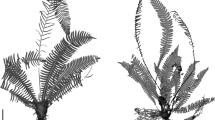Abstract
Sporichthyaceae, a family within the order “Frankiales,” includes the genus Sporichthya. Members of this family are facultative anaerobes and have a cell wall containing a large amount of LL-diaminopimelic acid. Sporichthya aerial hyphae grow upright on the surface of the medium through holdfasts, which are outgrowths of the basal cell wall. No substrate mycelium forms.
Similar content being viewed by others
References
Carlsohn MR, Groth I, Saluz HP, Schumann P, Stackebrandt E (2008) Fodinicola feengrottensis gen. nov., sp. nov., an actinomycete isolated from a medieval mine. Int J Syst Evol Microbiol 58:1529–1536
Collins MD, Faulkner M, Keddie RM (1984) Menaquinone composition of some spore forming actinomycetes. Syst Appl Microbiol 5:20–29
Elshahed MS, Youssef NH, Spain AM, Sheik C, Najar FZ, Sukharnikov LO, Roe BA, Davis JP, Schloss PD, Bailey VL, Krumholz LR (2008) Novelty and uniqueness patterns of rare members of the soil biosphere. Appl Environ Microbiol 74:5422–5428
Hansen AA, Herbert RA, Mikkelsen K, Jensen LL, Kristoffersen T, Tiedje JM, Lomstein BA, Finster KW (2007) Viability, diversity and composition of the bacterial community in a high Arctic permafrost soil from Spitsbergen, Northern Norway. Environ Microbiol 9:2870–2884
Hayakawa M, Nonomura H (1987) Humic acid-vitamin agar, a new medium for the selective isolation of soil actinomycetes. J Ferment Technol 65:501–509
Hayakawa M, Tamura T, Nonomura H (1991) Selective Isolation of Actinoplanes and Dactylosporangium from Soil by Using γ-Collidine as the Chemoattractant. J Ferment Bioeng 72:426–432
Hayakawa M, Otoguro M, Takeuchi T, Yamazaki T, Iimura Y (2000) Application of a method incorporating differential centrifugation for selective isolation of motile actinomycetes in soil and plant litter. Antonie Van Leeuwenhoek 78:171–185
Kroppenstedt RM (1985) Fatty acid and menaquinone analysis of actinomycetes and related organisms. In: Goodfellow M, Minnikin DE (eds) Chemical methods in bacterial systematics. Academic, London, pp 173–199
Lechevalier MP (1994) Taxonomy of the genus Frankia (Actinomycetales). Int J Syst Bacteriol 44:1–8
Lechevalier MP, Lechevalier HA, Holbert PE (1968) Sporichthya, un nouveau genre de Streptomycetaceae. Ann Inst Pasteur (Paris) 114:277–286 (in French)
Ludwig W, Euzéby J, Whitman WB (2012) Phylogenetic trees of the phylum Actinobacteria. In: Whitman WB, Goodfellow M, Kämpfer P, Busse H-J, Trujillo M, Garrity G, Ludwig W, Suzuki K-I (eds) Bergey’s manual of systematic bacteriology, vol 5, 2nd edn. Springer, New York
Luedemann GM, Fonseca AF (1989) Genus Geodermatophilus Luedemann 1968, 1857AL. In: Williams ST, Sharpe ME, Holt JG (eds) Bergey’s manual of systematic bacteriology, vol 4. Williams & Wilkins, Baltimore, pp 2406–2409
Mevs U, Stackebrandt E, Schumann P, Gallikowski CA, Hirsch P (2000) Modestobacter multiseptatus gen. nov., sp. nov., a budding actinomycete from soils of the Asgard Range (Transantarctic Mountains). Int J Syst Evol Microbiol 50:337–346
Mirza MS, Janse JD, Hahn D, Akkermans ADL (1991) Identification of atypical Frankia strains by fatty acid analysis. FEMS Microbiol Lett 83:91–98
Mohagheghi A, Grohmann K, Himmel M, Leighton L, Updegraff DM (1986) Isolation and characterization of Acidothermus cellulolyticus gen. nov., sp. nov., a new genus of thermophilic, acidophilic, cellulolytic bacteria. Int J Syst Bacteriol 36:435–443
Prauser H (1984) Phage host ranges in the classification and identification of Gram-positive branched and related bacteria. In: Ortiz-Ortiz LEA (ed) Biological, biochemical and biomedical aspects of actinomycetes. Academic, Orlando, pp 617–633
Rainey FA, Schumann P, Prauser H, Toalster R, Stackebrandt E (1993) Sporichthya polymorpha represents a novel line of descent within the order Actinomycetales. FEMS Microbiol Lett 109:263–268
Stackebrandt E, Rainey FA, Ward-Rainey NL (1997) Proposal for a new hierarchic classification system, Actinobacteria classis nov. Int J Syst Bacteriol 47:479–491
Suzuki S, Okuda T, Komatsubara S (1999) Selective Isolation and distribution of Sporichthya strains in soil. Appl Environ Microbiol 65:1930–1935
Takeuchi T, Hayakawa M, Yamazaki T (1996) A simplified approach to the selective isolation of motile actinomycetes. In: Abstracts of the 1996 annual meeting of the society for Actinomycetes Japan. The society for Actinomycetes Japan, Tokyo, Japan 2
Tamura T, Hayakawa M, Hatano K (1998) A new genus of the order Actinomycetales, Cryptosporangium gen. nov., with descriptions of Cryptosporangium arvum sp. nov. and Cryptosporangium japonicum sp. nov. Int J Syst Bacteriol 48:995–1005
Tamura T, Hayakawa M, Hatano K (1999) Sporichthya brevicatena sp. nov. Int J Syst Bacteriol 49:1779–1784
Urzì C, Salamone P, Schumann P, Rhode M, Stackebrandt E (2004) Blastococcus saxobsidens sp. nov., and emended descriptions of the genus Blastococcus Ahrens and Moll 1970 and Blastococcus aggregatus Ahrens and Moll 1970. Int J Syst Evol Microbiol 54:253–259
Williams ST, Goodfellow M, Alderson G (1989) Genus Sporichthya. In: Williams ST, Sharpe ME, Holt JG (eds) Bergey’s manual of systematic bacteriology, vol. 4. Williams and Wilkins, Baltimore, Md, pp 2507–2508
Yarza P, Ludwig W, Euzéby J, Amann R, Schleifer K-H, Glöckner FO, Rosselló-Móra R (2010) Update of the All-Species Living-Tree Project based on 16S and 23S rRNA sequence analyses. System Appl Microbiol 33:291–299
Yoon J-H, Kang S-J, Jung S-Y, Oh T-K (2007) Humicoccus flavidus gen. nov., sp. nov., isolated from soil. Int J Syst Evol Microbiol 57:56–59
Yoshimi Y, Hiraishi A, Nakamura K (1996) Isolation and characterization of Microsphaera multipartida gen. nov., sp. nov., a polysaccharide-accumulating Gram-positive bacterium from activated sludge. Int J Syst Bacteriol 46:519–525
Zhi XY, Li WJ, Stackebrandt E (2009) An update of the structure and 16S rRNA gene sequence-based definition of higher ranks of the class Actinobacteria, with the proposal of two new suborders and four new families and emended descriptions of the existing higher taxa. Int J Syst Evol Microbiol 59:589–608
Author information
Authors and Affiliations
Corresponding author
Editor information
Editors and Affiliations
Rights and permissions
Copyright information
© 2014 Springer-Verlag Berlin Heidelberg
About this entry
Cite this entry
Tamura, T. (2014). The Family Sporichthyaceae . In: Rosenberg, E., DeLong, E.F., Lory, S., Stackebrandt, E., Thompson, F. (eds) The Prokaryotes. Springer, Berlin, Heidelberg. https://doi.org/10.1007/978-3-642-30138-4_182
Download citation
DOI: https://doi.org/10.1007/978-3-642-30138-4_182
Published:
Publisher Name: Springer, Berlin, Heidelberg
Print ISBN: 978-3-642-30137-7
Online ISBN: 978-3-642-30138-4
eBook Packages: Biomedical and Life SciencesReference Module Biomedical and Life Sciences



